|
|
 |

Villa Pisani
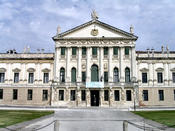
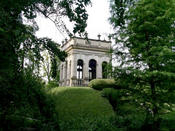
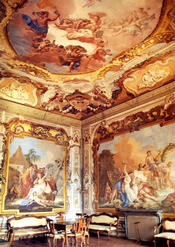
|
This is the grandest villa of the
Riviera. The Villa Pisani Nazionale di Strà was built in the 18th
century commissioned by the rich and prestigious Venetian Pisani family,
owner of numerous estates in that area. The works were begun as early as
in 1735 and had been commissioned by doge AlmorÚ Pisani to the Padua
architect Girolamo Fringimelica who, however, only carried out the stables
and a number of decorations in the garden. In fact, the real project was
completed by architect Francesco Maria Preti. The building has a rectangular
layout with two inner courtyards divided by a colonnade supporting the majestic
dance hall. The villa presents with an extraordinarily imposing facade:
the central body is spanned by a balcony supported by four monumental caryatids.
There are eight Corinthian-order half-pillars rising from the balcony. There
is also a cornice decorated with a flowery festoon supported by puttos from
which a triangular gable decorated with statues rises. The architectural
elements and the baroque ornaments of the park, the stables and the turrets
scattered along the fence are more dynamic and articulate. A recently-built
long pond runs straight along the northern facade of the villa. Two sumptuous
wrought-iron gates on both sides of the villa open the way to the park.
Close to the right wing gate there is a marble statue of Apollo sculpted
by Giovanni Bonazza about 1718. In the park, at the centre of a mound, there
is the "casa dei freschi", that is the ice-house designed by Fringimelica.
In the north-eastern direction it is possible to observe the fence and the
entrance to the orangery. In front of the villa, beside the long pond, there
are the stables which represent Fringimelica's most important work in the
park. The interior comprises a central body marked by an entrance hall and
by a dance hall developing on a double height and flanked by two small halls.
The first floor is reached by means of a staircase whose ceiling is decorated
with an "allegory" by Jacopo Guarana. The rooms are all intercommunicating
though disengaged from each other thanks to a corridor running along the
perimeter of the two courtyards. The first room presents with a ceiling
carrying a fresco representing the "Triumph of the Arts" by Crostato.
The next room has completely fresco-decorated walls with panels rich in
ornamentation and scenes illustrating the myth of Bacchus. The "Triumph
of Bacchus" on the ceiling repeats the typical pattern of the apotheosis
of the deity, whereas the "Bacchic Scenes" of the walls are brightened
by landscape elements. The decoration was carried out in 1770 by Jacopo
Guarana. The next three rooms have Empire style furniture and are followed
by the room of the dogi with marble busts of the dogi and other relief scenes.
The adjacent room presents on the ceiling the "Arraignment of Paris",
a canvas painted by Jacopo Amigoni. The room of Virtues presents with a
ceiling decorated with a canvas by Jacopo Guarana which represents the "Virtues"
whereas the walls are covered with canvasses depicting the "Liberal
Arts" painted by P.A. Novelli and G. Diziani.
|
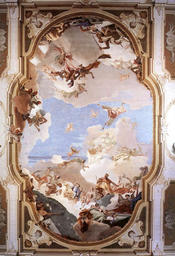
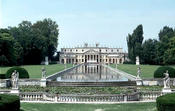
|
The ample hall decorated with frescos has the walls painted with pillars,
producing a perfectly working plastic effect and outlining dummy architectural
elements that surround the central work depicting the "Glory of the Pisani
family". The latter represents the members of the family surrounded by allegorical
personifications of the Arts, the Sciences and the Geniuses of Peace, before
Power and beneath the Virgin observing with benevolence Fame explaining
the glory and the power of the Pisani family to the world represented by
the continents. This fresco was painted by Gianbattista Tiepolo between
1760 and 1762 before he left for Spain. The banquet hall presents with remarkable
monochromatic decorations on the gallery painted by Gian Domenico Tiepolo
and with the brass gates at the doors which have been attributed to Giuseppe
Casa. In the approximately 10 hectares of the park of the villa Pisani there
are the main buildings of the park. First of all the stables, an imposing
perspective backdrop and a theatric scene, with its curved wings that improve
sonority, essential to characterize the equestrienne inspiration of the
park à la Vitruvio. Another symbolic element that must have been one of
the first realizations is the labyrinth, originally planned as circular
and inspired, with its turret served by a double helix that leads to the
statue of Minerva, to a ritual conquer of wisdom. The character of a game
is reflected by the presence of a hiding place, by the possibility of meeting
the others again while walking through the labyrinth in illusory frames
that recall paintings and sculptures and by the peculiar hexagonal exedra
with curved sides, where a winding staircase leads to a belvedere with a
round window that allows those who are downstairs to see, like in a painting
of Mantegna or Coreggio, who is upstairs. The exedra is also the center
from where many of the perspective axis start, that have on the other end
the citrus orchard, the sculpture groups of Bonazza and the fencing portals,
among which the most interesting one is the one called "of the Belvedere",
characterized by a double slope, around gigantic columns, that leads to
the suspended crowning path. Also those realizations that are more tied
to a practical use, like the houses of the gardeners beside the exedra and
the tea time lodge with the ice-house underneath, participate to the theatricality
of the complex, that is strong enough to transform the former in a light
green backdrop and the latter in a artificial hill surmounted by a little
palace. Only the greenhouses completed in the first half of the 19th century,
present, with their technological refinement, an austerely utilitarian character.
With the collapse of the Serenissima the villa was sold to Napoleon who
donated it to the Viceroy of Italy Eugenio Beauharnais. In 1814 the villa
fell into the hands of the Emperor of Austria and in 1866 in those of the
Savoy family and was finally ceded to the public domain in 1882.
|
|
 |
|